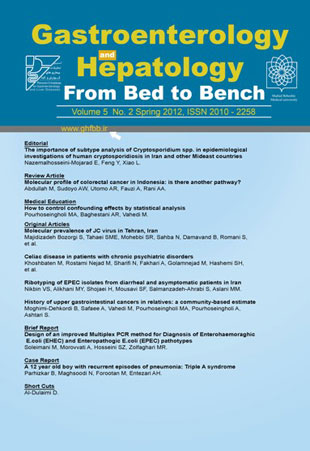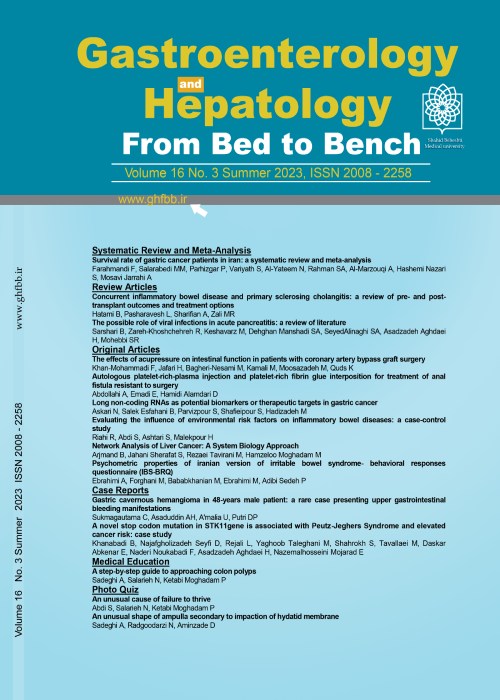فهرست مطالب

Gastroenterology and Hepatology From Bed to Bench Journal
Volume:5 Issue: 2, Spring 2012
- تاریخ انتشار: 1390/12/24
- تعداد عناوین: 10
-
-
Page 71Colorectal cancer is an emerging public health problem in Indonesia and currently ranks among the three highest cancers. Lack of a colonoscopy screening and lifestyle changes might contribute to it. In the last few decades, there is an increasing interest towards the contribution of genetic-environment interaction in colorectal carcinogenesis. Some studies have indicated that CRC might develop through several different pathways; the three major routes are chromosomal instability (CIN), microsatellite instability (MSI), and inflammatory pathways. An earlier study on clinical epidemiology of CRC in Indonesia showed that the majority of patients were diagnosed between 45 and 50 years old, with a mean age around 47 years old. Further studies showed that most young Indonesian cases of CRC do not have hereditary characteristics; however, the CRC did not follow the conventional pathways of sporadic CRC (the CIN) pathway. Rather, it is a mixed of MSI and inflammatory pathways. Immunohistochemical studies showed that the proportion of patients with negative mismatch repair proteins was 43.5% for MSH2 and 83.5% for MLH1. Along the sporadic colorectal carcinogenesis pathway, there was a specific role of cyclooxygenase-2 (COX-2) enzyme during the polyp formation. COX-2 expression was reported in about 80% CRC cases worldwide. However, our study found only 49% of COX-2 expression among the CRC patients. Interestingly, an inflammatory marker, the nucleus factor? B (NF-?B), was expressed in about 73.5% cases, in line with a previous study. More recently, KRAS has been used as a potential tumor marker to select treatment and its expression was reported to be as high as 30%-40% worldwide. However, we found that KRAS gene expression was only 16.3%. Our findings support that CRC patients in Indonesian might follow a distinct pathway, a hypothesis that deserves further exploration.
-
Page 79A Confounder is a variable whose presence affects the variables being studied so that the results do not reflect the actual relationship. There are various ways to exclude or control confounding variables including Randomization, Restriction and Matching. But all these methods are applicable at the time of study design. When experimental designs are premature, impractical, or impossible, researchers must rely on statistical methods to adjust for potentially confounding effects. These Statistical models (especially regression models) are flexible to eliminate the effects of confounders.
-
Page 84AimSince data about prevalence of JC virus in Iranian population is scarce, this study was designed to evaluate the prevalence of JC virus in healthy individuals who had attended Fajr hospital and Farjam clinical laboratory in Tehran, Iran.BackgroundJC virus is the causative agent of progressive multifocal encephalopathy (PML) in individuals with suppressed immune system. There are some evidences that this virus is responsible for some forms of cancers for example colorectal and gastric cancers in humans. Patients andMethodsUrine samples from 133 healthy individuals older than 18 years old were collected and after extraction of viral DNA, PCR was performed to determine the presence of virus. Results of the test and demographic data of subjects were entered into SPSS program and were analyzed by it.Results71 subjects were male and 62 individuals were female. Mean age of the population was 42.23 ± 13.47. From the total number of 133 subjects, 51 (38.3%) individuals were positive for the presence of JC virus. Gender had statistically significant relationship with JC virus presence (p= 0.042). Age was not significantly related to JC virus presence status (p= 0.3).ConclusionObtained rate of JC prevalence in this study is similar to the results of studies in India and Philippine. Because of this virus’s role in AIDS and the role of this virus in gastrointestinal cancers have been revealed in recent years, the more extended studies on the prevalence of this virus in different populations in Iran is necessary.
-
Page 90AimThe aim of this study was to determine the prevalence of celiac disease in Iranian patients suffering from chronic depression or schizophrenia.BackgroundPsychiatric disorders are common in untreated celiac disease. Patients andMethodsTwo hundred Iranian inpatient men with in chronic phase of depressive disorders or schizophrenia, and 200 age-matched healthy male subjects were screened for celiac disease by anti-tissue transglutaminase IgA antibodies. The mean age of the study patients was 37 years.ResultsOne (1 %) schizophrenic and two (2%) depressive patients were positive for anti-tissue transglutaminase IgA antibodies; duodenal biopsy was not possible in these subjects. In the control group one (0.5%) individual was positive for anti-tissue transglutaminase IgA antibodies, but had normal duodenal histology. The difference between patients and controls was not statistically significant.ConclusionThe frequency of celiac disease serology in schizophrenic and depressive inpatients was not significantly higher than that in the general population. We would therefore not advocate systematic serologic screening in these patients, but alertness to celiac disease should be kept in mind.
-
Page 94AimWe intended to find out the diversity of EPEC isolates among asymptomatic or diarrheal children in Iran using ribotyping.BackgroundEnteropathogenic Escherichia coli (EPEC) is responsible for gastroenteritis especially in young children. Patients andMethodsA total of 39 EPEC collected strains were serotyped and the presence of virulence genes as well as EAF plasmid among the strains was studied. Adherence assay was also performed. Clonal diversity of the isolates was investigated using ribotyping.ResultsOf 39 studied strains of E. coli, 6 serogroups of EPEC were represented. The presence of the stx gene was ascertained in 7 isolates and the eaeA, eaeB and bfpA genes were harbored by 5, 3 and 1 strains, respectively. Ribotyping yielded 9 different clusters.ConclusionAccording to our results there was not a significant correlation between the results of serotyping and those of ribotyping. However, different serotypes of E. coli may belong to the same ribotype clusters and vice versa.
-
Page 100AimThe present study aimed to evaluate the prevalence of positive family history of these cancers in a large population-based sample of Tehran province, capital of Iran.BackgroundUpper gastrointestinal (UGI) cancers (gastric and esophagus cancer) constitute a major health problem worldwide. A family history of cancer can increase the risk for developing cancer and recognized as one of the most important risk factors in predicting personal cancer risk. Patients andMethodsThis study designed as a cross-sectional survey in general population (2006-2007) of Tehran province. Totally 7,300 persons (age>= 20 years) sampled by random sampling on the basis of the list of postal, of whom 6,700 persons agreed to participate (response rate 92%). Respondents were asked if any first-degree (FDR) or second-degree (SDR) relatives had gastric or esophageal cancer.ResultsTotally, 6,453 respondents (48% male) entered to the study. The mean age of responders with positive FH was significantly higher than those with negative FH (P<0.05). In total, 341 respondents (5.3%) reporting a history of UGI cancers in their relatives, 134(2.1%) in FDRs, and 207(3.2%) in SDRs.ConclusionOur findings showed that the reported prevalence of FH of UGI cancers was relatively low and varied by specific respondent characteristics such as age and sex. However, the estimates of prevalence presented here are likely to be conservative compared with actual prevalence because of self-reported data gathering.
-
Page 106AimWe aimed to develop a multiplex PCR assay for specific detection of EPEC and EHEC pathotypes based on specific marker genes.BackgroundAbout 2.5 million infant’s morbidity in developing countries occurs by E.coli pathotypes because of diarrhea and intestinal diseases. The traditional phenotypic methods are time consuming and sometimes detection and differentiation of the pathotypes are not done easily. Multiplex PCR technology is used as a sensitive, specific and rapid molecular method for detection of various pathogens. Patients andMethodsPCR reactions were performed with primers which targeted the virulence genes selected for each category (stx1, stx2 genes for EHEC and bfpA for EPEC).For preparation of a positive control, the PCR products were cloned in pTZ57R/T plasmid. The same PCR reactions were done but in presence of genomes of various negative control bacteria for evaluation of test specificity.ResultsAs expected, gel agarose electrophoresis of PCR products of the stx1, stx2 and bfpA, showed 329bp, 586bp and459bp bands respectively. Result of amplification using negative control genomes as template was negative.ConclusionThe multiplex PCR assay followed by capillary electrophoresis presented in the present paper provides a simple, reliable, and rapid procedure that in a single reaction identifies the four main pathotypes of E. coli. This assay will replace the previous molecular genetics methods used in our laboratory and work as an important supplement to the more time consuming phenotypic assays.
-
Page 112Triple A syndrome (Allgrove syndrome) is a rare inherited autosomal recessive disease with a typical triad including adrenocorticotrophic-hormone-resistant glucocorticoid insufficiency, reduced or absent tearing (alacrima) and achalasia and a wide range of symptoms can be detected due to multi organ involvement. This report describes the case of a Triple Asyndrome, a12 year-old boy with a history of recurrent episodes of pneumonia and growth retardation due to failure to timely diagnosis of his problem.
-
Page 116


